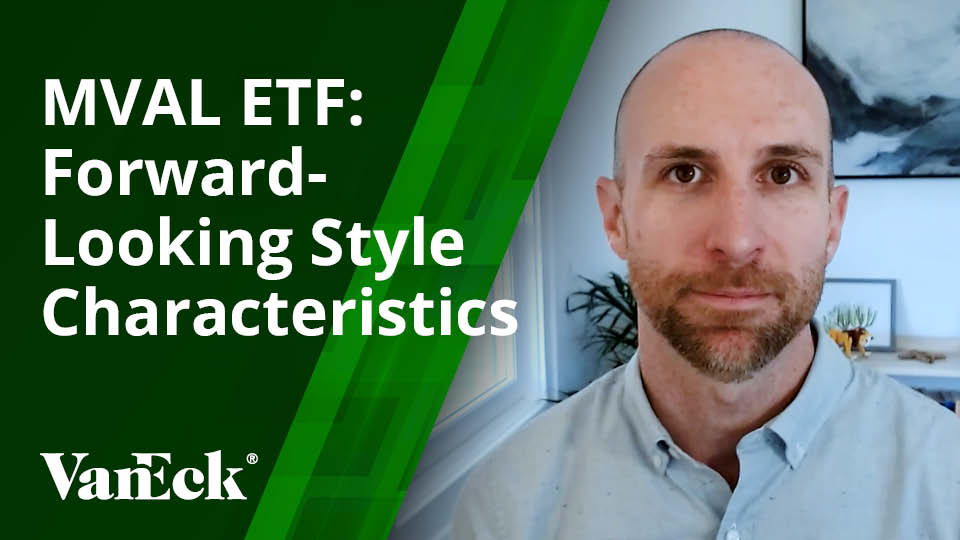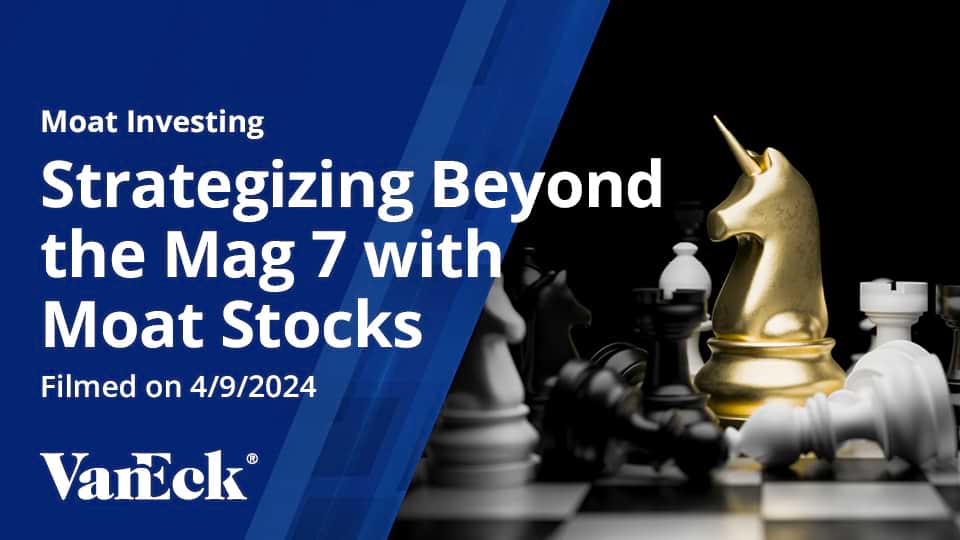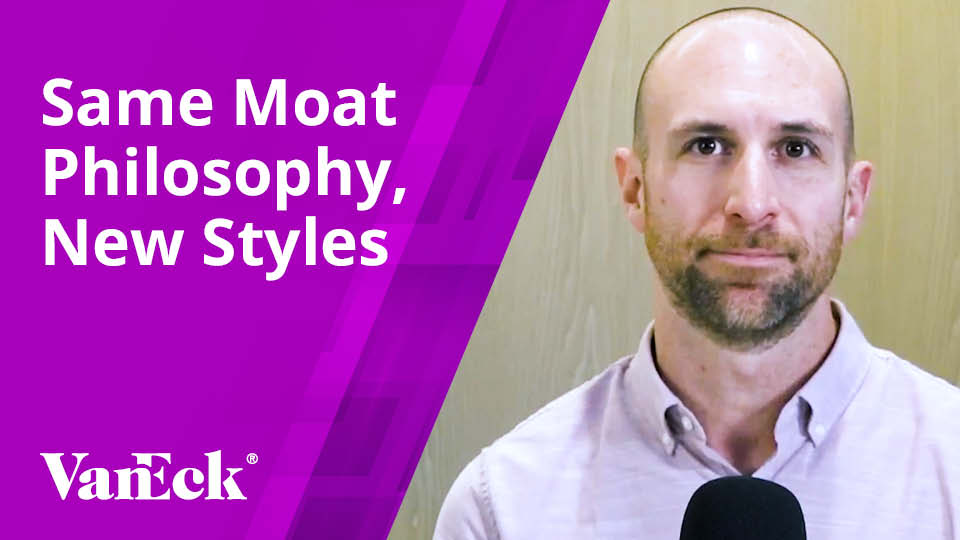MOAT ETF: Question & Answer
May 12, 2023
Read Time 4 MIN
Morningstar’s approach to moat investing starts with companies with sustainable competitive advantages and targets those trading at attractive valuations. We explore in this Q&A.
Moat investing is based on a simple concept: invest in companies with sustainable competitive advantages. Morningstar builds on this philosophy by seeking out moat stocks trading at attractive valuations relative to their equity research team’s forward-looking estimate of fair value. This approach has stood the test of time, with the live track record for the Morningstar® Wide Moat Focus IndexSM (“Moat Index”) exceeding 15 years. This blog is intended to address frequently asked questions about Morningstar’s moat investing philosophy and the VanEck Morningstar Wide Moat ETF (MOAT).
- How is Morningstar’s equity research incorporated into the Moat Index?
- How does Morningstar identify moat companies?
- How does Morningstar determine the width of moat and what makes a particular advantage short vs long term?
- Is MOAT an actively managed ETF?
- What has most influenced the Moat Index’s performance historically?
- How frequently does the Moat Index rebalance?
- What style exposure does MOAT offer?
- Does MOAT pay capital gains?
- How does MOAT fit in a portfolio?
- How can investors buy VanEck ETFs?
How is Morningstar’s equity research incorporated into the Moat Index?
The Moat Index is fueled by Morningstar’s forward-looking, rigorous equity research process, driven by over 100 analysts globally. All of Morningstar’s equity analysts follow a single, consistent research methodology. Morningstar’s economic moat rating serves as the cornerstone of Morningstar’s equity research philosophy. The goal is to determine which companies have competitive advantages that will lead to returns on invested capital in excess of the companies’ weighted cost of capital. Just as important is determining how long those companies can maintain their advantages. The exclusive group of wide moat rated companies are expected to maintain their competitive advantages for more than 20 years into the future.
Morningstar considers a company’s economic moat rating when forecasting future cash flow and discounting those future cash flows to arrive at a current intrinsic per share value for each company. Their valuation process does not take shortcuts, and cash flows are regularly forecasted well into the future.
The Index leverages Morningstar’s economic moat ratings and fair value estimates to systematically assemble the Index’s portfolio each quarter.
How does Morningstar identify moat companies?
Morningstar has identified five attributes that may contribute to a company’s moat: switching costs, intangible assets, network effect, cost leadership and efficient scale. Companies may demonstrate one or a combination of these five sources of moat. Evaluating companies against these attributes are a key part of how Morningstar’s equity research team gauges the strength of a company’s competitive advantage. This assessment results in one of three economic moat ratings: none, narrow or wide. A wide moat rating is assigned to a company that is likely to sustain its competitive advantage for at least the next 20 years, while a narrow moat rating means a company is likely to do so for at least 10 years. A company with no moat has either no advantage or one expected to dissipate relatively quickly.
A wide economic moat rating from Morningstar’s equity analysts is rare. Morningstar’s equity coverage universe skews toward companies with economic moats, yet only 10-15% of those companies receive the elusive wide moat rating. That percentage would likely be far lower for a more comprehensive group of U.S and global companies. Stated differently, it is very difficult to find companies that possess the attributes Morningstar requires to assign a wide moat rating and therefore very few receive that designation.
How does Morningstar determine the width of moat and what makes a particular advantage short vs long term?
This determination involves a number of considerations, both qualitative and quantitative. From a qualitative perspective, Morningstar consider the nature of the company’s competitive advantage and how effectively it will persist given the industry in which the company operates. For example, a tech company may have a strong competitive advantage, but it receives a narrow moat rating because industry in which it operates is subject to a rapid pace of technological change and the risk of disruption is far higher in the tech industry than other industries. Conversely, consider a packaged goods company with an incredible brand that produces unhealthy snack food may receive a wide moat rating. The pace at which this company’s brand equity is likely to fade is far slower than the pace of technological change and disruption in the certain areas of the tech space. Ultimately, certain sectors and industries are far more conducive to economic moats than others.
The next consideration is more quantitative in nature. Morningstar looks at a company’s current and projected returns on invested capital (ROIC) vs. its weighted average cost of capital (WACC) in order to determine what would have to happen for that ROIC to converge downward with its WACC. Once a company’s ROIC and WACC are at parity, economic profits are no longer earned. In some cases, even when a company is in secular decline, its ROIC might be so high that it would take decades for that ROIC to realistically decline down to the company’s WACC. This may apply to tobacco companies or possibly the packaged goods company example above. However, when the spread between ROIC and WACC is thinner, Morningstar requires more conviction in the durability of the competitive advantage before assigning a wide moat rating to the company. Ultimately, the durability of economic profits matters far more than the current magnitude of economic profits when determining the “width” of a company’s economic moat. However, a high magnitude of economic profits does leave the company more margin for error before economic profits would realistically disappear.
Each industry has its own “economic moat framework” each analyst should consider when determining appropriate economic moat ratings.
Visit the fund page for the fact sheet, holdings, performance and more.
Is MOAT an actively managed ETF?
No, MOAT is an index-based ETF. MOAT seeks to replicate, before fees and expenses, the price and yield performance of the Moat Index. The Index is unique in the world of index investing because it leverages Morningstar’s 100+ person equity research team to systematically identify what Morningstar equity research analysts considers attractively priced companies with sustainable competitive advantages.
What has most influenced the Moat Index’s performance historically?
This long-term, core investment approach has resulted in excess returns relative to the broad U.S. equity markets since 2007, and often displays excess returns following periods of sizable market declines. The Moat Index’s focus on companies with competitive advantages and attractive valuations results in a dynamic portfolio that has potential to outperform on both the upside and down side. Historically, the Index has benefited primarily from strong stock selection as opposed to sector, size or style over/underweights.
How frequently does the Moat Index rebalance?
The Index employs a staggered rebalance methodology whereby the Index is divided into two equally-weighted sub-portfolios, and each is reconstituted and rebalanced semi-annually on alternating quarters. Adjustments to one sub-portfolio are performed on the third Friday of March and September, and adjustments for the other sub-portfolio are performed on the third Friday of June and December. Due to the staggered rebalance methodology, Index constituents and weights may vary between sub-portfolios.
What style exposure does MOAT offer?
MOAT has historically provided a large blend exposure to U.S. equities. Morningstar’s valuation methodology allows the Moat Index to target opportunities among wide moat stocks regardless of style exposure. Therefore, both the Index and MOAT have seen their style exposure drift between growth and value through time.
Does MOAT pay capital gains?
As a regulated investment company, MOAT must pass through income and capital gains to shareholders each year. Despite turnover in excess of typical index-based U.S. equity ETFs, MOAT has never paid a capital gain distribution. This has held true despite its 2012 launch corresponding with the early years of a sustained bull market in U.S. stocks.
How does MOAT fit in a portfolio?
MOAT offers investors a diversified portfolio of U.S. equities that can serve as a core portfolio building block. Investors should consider MOAT for long-term exposure as opposed to opportunistic tactical market exposure. The Moat Index has historically had more success relative to broad beta indexes over longer-periods of time than short time periods.
How can investors buy VanEck ETFs?
To receive more Moat Investing insights, sign up in our subscription center.
Related Topics
Related Insights
April 10, 2024
Important Disclosures
Definitions
Return on Invested Capital (ROIC) – a performance ratio that aims to measure the percentage return that a company earns on invested capital and shows how efficiently a company uses funds to generate income.
Weighted Average Cost of Capital (WACC) – the average rate that a business pays to finance its assets. This is calculated by averaging the rate of all the company’s sources of capital weighted by the proportion of each component.
The information presented does not involve the rendering of personalized investment, financial, legal, or tax advice. Certain statements contained herein may constitute projections, forecasts and other forward looking statements, which do not reflect actual results, are valid as of the date of this communication and subject to change without notice. Information provided by third party sources are believed to be reliable and have not been independently verified for accuracy or completeness and cannot be guaranteed. The information herein represents the opinion of the author(s), but not necessarily those of VanEck or its employees.
The Morningstar® Wide Moat Focus IndexSM was created and is maintained by Morningstar, Inc. Morningstar, Inc. does not sponsor, endorse, issue, sell, or promote the VanEck Morningstar Wide Moat ETF and bears no liability with respect to that ETF or any security. Morningstar® is a registered trademark of Morningstar, Inc. Morningstar® Wide Moat Focus IndexSM is a service mark of Morningstar, Inc.
The Morningstar® Wide Moat Focus IndexSM consists of U.S. companies identified as having sustainable, competitive advantages and whose stocks are attractively priced, according to Morningstar.
Effective June 20, 2016, Morningstar implemented several changes to the Morningstar Wide Moat Focus Index construction rules. Among other changes, the index increased its constituent count from 20 stocks to at least 40 stocks and modified its rebalance and reconstitution methodology. These changes may result in more diversified exposure, lower turnover and longer holding periods for index constituents than under the rules in effect prior to this date.
Index returns are not representative of fund returns. Investors cannot invest directly in the Index.
An investment in the VanEck Morningstar Wide Moat ETF (MOAT®) may be subject to risks which include, among others, risks related to investing in equity securities, consumer discretionary sector, health care sector, industrials sector, information technology sector, financials sector, medium-capitalization companies, market, operational, high portfolio turnover, index tracking, authorized participant concentration, no guarantee of active trading market, trading issues, passive management, fund shares trading, premium/discount risk and liquidity of fund shares, non-diversification and index-related concentration risks, all of which may adversely affect the Fund. Medium-capitalization companies may be subject to elevated risks.
The S&P® 500 Index consists of 500 widely held common stocks covering industrial, utility, financial and transportation sector; as an Index, it is unmanaged and is not a security in which investments can be made.
The S&P 500 Index is a product of S&P Dow Jones Indices LLC and/or its affiliates and has been licensed for use by Van Eck Associates Corporation. Copyright © 2022 S&P Dow Jones Indices LLC, a division of S&P Global, Inc., and/or its affiliates. All rights reserved. Redistribution or reproduction in whole or in part are prohibited without written permission of S&P Dow Jones Indices LLC. For more information on any of S&P Dow Jones Indices LLC’s indices please visit www.spglobal.com/spdji/en/. S&P® is a registered trademark of S&P Global and Dow Jones® is a registered trademark of Dow Jones Trademark Holdings LLC. Neither S&P Dow Jones Indices LLC, Dow Jones Trademark Holdings LLC, their affiliates nor their third party licensors make any representation or warranty, express or implied, as to the ability of any index to accurately represent the asset class or market sector that it purports to represent and neither S&P Dow Jones Indices LLC, Dow Jones Trademark Holdings LLC, their affiliates nor their third party licensors shall have any liability for any errors, omissions, or interruptions of any index or the data included therein.
Investing involves substantial risk and high volatility, including possible loss of principal. An investor should consider a Fund's investment objective, risks, charges and expenses carefully before investing. To obtain a prospectus and summary prospectus for VanEck Funds and VanEck ETFs, which contain this and other information, call 800.826.2333 or visit vaneck.com. Please read the prospectus and summary prospectus for VanEck Funds and VanEck ETFs carefully before investing.
© Van Eck Securities Corporation, Distributor, a wholly owned subsidiary of Van Eck Associates Corporation.
Related Funds
Important Disclosures
Definitions
Return on Invested Capital (ROIC) – a performance ratio that aims to measure the percentage return that a company earns on invested capital and shows how efficiently a company uses funds to generate income.
Weighted Average Cost of Capital (WACC) – the average rate that a business pays to finance its assets. This is calculated by averaging the rate of all the company’s sources of capital weighted by the proportion of each component.
The information presented does not involve the rendering of personalized investment, financial, legal, or tax advice. Certain statements contained herein may constitute projections, forecasts and other forward looking statements, which do not reflect actual results, are valid as of the date of this communication and subject to change without notice. Information provided by third party sources are believed to be reliable and have not been independently verified for accuracy or completeness and cannot be guaranteed. The information herein represents the opinion of the author(s), but not necessarily those of VanEck or its employees.
The Morningstar® Wide Moat Focus IndexSM was created and is maintained by Morningstar, Inc. Morningstar, Inc. does not sponsor, endorse, issue, sell, or promote the VanEck Morningstar Wide Moat ETF and bears no liability with respect to that ETF or any security. Morningstar® is a registered trademark of Morningstar, Inc. Morningstar® Wide Moat Focus IndexSM is a service mark of Morningstar, Inc.
The Morningstar® Wide Moat Focus IndexSM consists of U.S. companies identified as having sustainable, competitive advantages and whose stocks are attractively priced, according to Morningstar.
Effective June 20, 2016, Morningstar implemented several changes to the Morningstar Wide Moat Focus Index construction rules. Among other changes, the index increased its constituent count from 20 stocks to at least 40 stocks and modified its rebalance and reconstitution methodology. These changes may result in more diversified exposure, lower turnover and longer holding periods for index constituents than under the rules in effect prior to this date.
Index returns are not representative of fund returns. Investors cannot invest directly in the Index.
An investment in the VanEck Morningstar Wide Moat ETF (MOAT®) may be subject to risks which include, among others, risks related to investing in equity securities, consumer discretionary sector, health care sector, industrials sector, information technology sector, financials sector, medium-capitalization companies, market, operational, high portfolio turnover, index tracking, authorized participant concentration, no guarantee of active trading market, trading issues, passive management, fund shares trading, premium/discount risk and liquidity of fund shares, non-diversification and index-related concentration risks, all of which may adversely affect the Fund. Medium-capitalization companies may be subject to elevated risks.
The S&P® 500 Index consists of 500 widely held common stocks covering industrial, utility, financial and transportation sector; as an Index, it is unmanaged and is not a security in which investments can be made.
The S&P 500 Index is a product of S&P Dow Jones Indices LLC and/or its affiliates and has been licensed for use by Van Eck Associates Corporation. Copyright © 2022 S&P Dow Jones Indices LLC, a division of S&P Global, Inc., and/or its affiliates. All rights reserved. Redistribution or reproduction in whole or in part are prohibited without written permission of S&P Dow Jones Indices LLC. For more information on any of S&P Dow Jones Indices LLC’s indices please visit www.spglobal.com/spdji/en/. S&P® is a registered trademark of S&P Global and Dow Jones® is a registered trademark of Dow Jones Trademark Holdings LLC. Neither S&P Dow Jones Indices LLC, Dow Jones Trademark Holdings LLC, their affiliates nor their third party licensors make any representation or warranty, express or implied, as to the ability of any index to accurately represent the asset class or market sector that it purports to represent and neither S&P Dow Jones Indices LLC, Dow Jones Trademark Holdings LLC, their affiliates nor their third party licensors shall have any liability for any errors, omissions, or interruptions of any index or the data included therein.
Investing involves substantial risk and high volatility, including possible loss of principal. An investor should consider a Fund's investment objective, risks, charges and expenses carefully before investing. To obtain a prospectus and summary prospectus for VanEck Funds and VanEck ETFs, which contain this and other information, call 800.826.2333 or visit vaneck.com. Please read the prospectus and summary prospectus for VanEck Funds and VanEck ETFs carefully before investing.
© Van Eck Securities Corporation, Distributor, a wholly owned subsidiary of Van Eck Associates Corporation.


